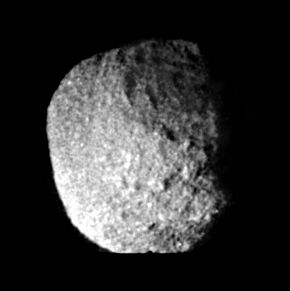
Back Proteus (maan) Afrikaans Proteu (satelite) AN بروتيوس (قمر) Arabic پروتیوس (قمر) AZB Пратэй (спадарожнік Нептуна) Byelorussian Протей (спътник) Bulgarian প্রোটিয়াস (প্রাকৃতিক উপগ্রহ) Bengali/Bangla Proteu (satèl·lit) Catalan Proteus (ôi-sĭng) CDO Proteus (měsíc) Czech
 Processed grayscale image of Proteus from Voyager 2, August 1989 (image processing date). The massive crater Pharos occupies much of the upper right, straddling Proteus's terminator | |
| Discovery | |
|---|---|
| Discovered by | Voyager 2 Stephen P. Synnott |
| Discovery date | June 16, 1989 |
| Designations | |
Designation | Neptune VIII |
| Pronunciation | /ˈproʊtiəs/ PROH-tee-əs[1] |
Named after | Πρωτεύς or Πρωτέας, Prōteys or Prōteas |
| S/1989 N 1 | |
| Adjectives | Protean (/ˈproʊtiən/ PROH-tee-ən or /proʊˈtiːən/ proh-TEE-ən)[2] |
| Orbital characteristics[3] | |
| Epoch 18 August 1989 | |
| Periapsis | 117584±10 km |
| Apoapsis | 117709±10 km |
| 117647±1 km (4.75 RN) | |
| Eccentricity | 0.00053±0.00009 |
| 1.12231477±0.00000002 d | |
Average orbital speed | 7.623 km/s |
| Inclination | 0.524° (to Neptune's equator) 0.026°±0.007° (to local Laplace plane) |
| Satellite of | Neptune |
| Physical characteristics | |
| Dimensions | 424 km × 390 km × 396 km[4] [a] |
| 209±8 km[6] 210±7 km[7] | |
| 554 200 km2[8] | |
| Volume | (3.4±0.4)×107 km3[4] |
| Mass | ≈ (1.55–3.10)×1019 kg[b] ≈ (2.60–5.20)×10−6 Earths |
Mean density | ≈ 0.46–0.91 g/cm3[9][c] |
| ≈ 0.023–0.054 m/s2[d] | |
| ≈ 0.099–0.146 km/s[e] | |
| synchronous[4] | |
| zero[4] | |
| Albedo | 0.096[10][7] |
| Temperature | ≈ 51 K mean (estimate) |
| 19.7[10] | |
Proteus (/ˈproʊtiəs/ PROH-tee-əs), also known as Neptune VIII, is the second-largest Neptunian moon, and Neptune's largest inner satellite. Discovered by Voyager 2 in 1989, it is named after Proteus, the shape-changing sea god of Greek mythology.[11] Proteus orbits Neptune in a nearly equatorial orbit at a distance of about 4.75 times the radius of Neptune's equator.[3]
Despite being a predominantly icy body more than 400 km (250 mi) in diameter, Proteus's shape deviates significantly from an ellipsoid.[6] It is shaped more like an irregular polyhedron with several slightly concave facets and relief as high as 20 km (12 mi). Its surface is dark, neutral in color, and heavily cratered.[12] Proteus's largest crater is Pharos, which is more than 230 km (140 mi) in diameter. There are also a number of scarps, grooves, and valleys related to large craters.
Proteus is probably not an original body that formed with Neptune. It could have accreted later from the debris formed when the largest Neptunian satellite, Triton, was captured.[13]
- ^ "Proteus". Lexico UK English Dictionary. Oxford University Press. Archived from the original on March 22, 2020.
- ^ "Protean". Oxford English Dictionary (Online ed.). Oxford University Press. (Subscription or participating institution membership required.)
- ^ a b Cite error: The named reference
Jacobson2004was invoked but never defined (see the help page). - ^ a b c d e f g Cite error: The named reference
Stooke1994was invoked but never defined (see the help page). - ^ Cite error: The named reference
Williams2008-nssdcwas invoked but never defined (see the help page). - ^ a b c Cite error: The named reference
Croft1992was invoked but never defined (see the help page). - ^ a b c Cite error: The named reference
Karkoschka2003was invoked but never defined (see the help page). - ^ "Proteus By The Numbers". solarsystem.nasa.gov/. Retrieved September 4, 2020.
- ^ a b Cite error: The named reference
ZhangHamiltonIIwas invoked but never defined (see the help page). - ^ a b Cite error: The named reference
jplssdwas invoked but never defined (see the help page). - ^ Cite error: The named reference
IAUC 5347was invoked but never defined (see the help page). - ^ Cite error: The named reference
DumasSmithTerrile2003was invoked but never defined (see the help page). - ^ Cite error: The named reference
Goldreich1989was invoked but never defined (see the help page).
Cite error: There are <ref group=lower-alpha> tags or {{efn}} templates on this page, but the references will not show without a {{reflist|group=lower-alpha}} template or {{notelist}} template (see the help page).